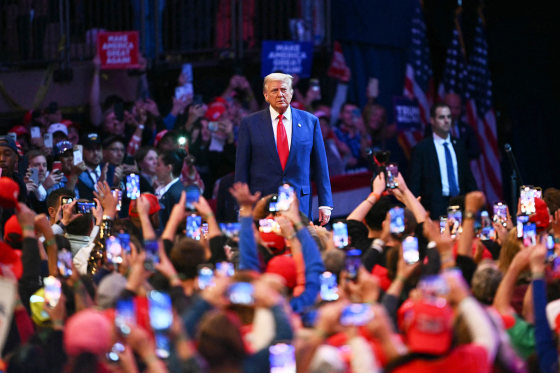Former President Donald Trump’s promises that he’ll win New York are more empty bluster than evidence-based prediction. But the down-ballot reality is murkier for Democrats amid signs Trump and his party are running stronger this year against Vice President Kamala Harris in key areas of the state.
A recent New York Times/Siena College poll found Harris leading Trump 66%-27% among likely voters in New York City — a healthy lead but about 10 points short of President Joe Biden’s vote share in 2020, suggesting some slippage in the liberal city. Two statewide Siena polls have also found Trump performing better than his 2020 vote share in New York state as a whole.
Meanwhile, an aggregate of internal House Republican battleground polling from six competitive New York congressional districts obtained by NBC News finds Trump winning those districts by an average of 1 percentage point. That doesn’t mean Trump is winning all of these districts, but it is a significant change from 2020, when, on average, Biden won the same competitive districts by a roughly 8-point margin.
The six districts polled by the National Republican Congressional Committee in August, September and October are the 1st and 4th districts on Long Island, the 17th, 18th and 19th districts in the Hudson Valley and the 22nd District around Syracuse. Importantly, pooling the districts together may flatten out variations among them: The 1st District, for example, is significantly more pro-Trump than the 22nd, around Syracuse, which can move the averages. And the Siena polls, which show mild movement for Trump statewide but more significant movement compared with 2020 in New York City, demonstrate how different areas could be reacting differently in this election.
But overall, these races include the most competitive around the state, and all but the 18th District are currently represented in Congress by Republicans.
Trump allies, like Rep. Elise Stefanik of New York, were quick to highlight the opportunity.
“Kamala Harris is underperforming every single swing district in New York …compared to where Joe Biden was in 2020,” Stefanik said in an interview. Trump’s “vision for New York — and it is the correct one — is that Democrat-controlled states have had years and years of decay because of failed, far-left policies, and that’s why you’re seeing, since Trump ran in 2016, you’re seeing a tectonic shift in New York politics, increasing Republican numbers.”
New York is solidly Democratic at the presidential level, though Trump improved there by about a point from 2016 to 2020, getting 37.7% of the vote. He has held two rallies during the waning weeks of the election — one on Long Island, the other in the heart of New York City at Madison Square Garden. Democrats are not concerned about the top of the ticket, but for those races down ballot — Democrats lost five competitive House races here in 2022 — this election is a chance to earn back what was once theirs. A net gain of just four seats nationwide would flip House control back to Democrats.
The situation is only complicated by statewide politics and the woes of the state’s most prominent Democrats: New York Mayor Eric Adams’ recent indictment on corruption charges could bleed into the commuter-heavy suburbs, and a recent Siena poll of Gov. Kathy Hochul’s approval rating found her trailing even Trump’s numbers.
House Democratic leader Hakeem Jeffries, who represents the Brooklyn area, downplayed any concerns about the impact of statewide or national figures on key House races from his side of the aisle in an interview last month. He said House candidates would run their own races.
“They have their own track record of success and vision for the future in terms of delivering for the people that they hope to represent,” Jeffries said.
But Republicans have their eye on some local issues.
“Progressive state issues like bail reform and congestion pricing remain challenging for Democrats in the New York suburbs,” longtime New York Republican operative Matt Coleman said, adding that “even as Hochul ‘paused’ implementation of $15 extra tolls for driving into Manhattan until after the election,” the issue is one that remains an albatross.
Privately, some Democrats concede those issues could have a negative impact on tight races.
“Hochul has taken her eye off the ball,” a Democratic operative working in New York races said, speaking anonymously to be more candid about one of the party’s key statewide leaders. “She has been negligent in taking threats seriously, and that’s leaving key House races and other progressive priorities in jeopardy.”
A Hochul spokeswoman countered that the governor has been working “tirelessly” on get out the vote efforts, including an “unprecedented coordinated campaign” that works in tandem with DCCC efforts to flip House seats here.
But while polling and demographic shifts might have Republicans energized, Trump’s recent rally at Madison Square Garden, featuring racist and controversial comments about Puerto Ricans and other groups, shows the other side of the political coin: Trump’s unpredictability and the potential negative impact on House Republicans. Less than 24 hours after the event, GOP Reps. Mike Lawler and Anthony D’Esposito both came out to condemn the comments about Puerto Ricans.
“Obviously, voter turnout will drive the ultimate results,” Coleman, the GOP strategist, concluded, “but the top of the ticket is playing a role in this.”

